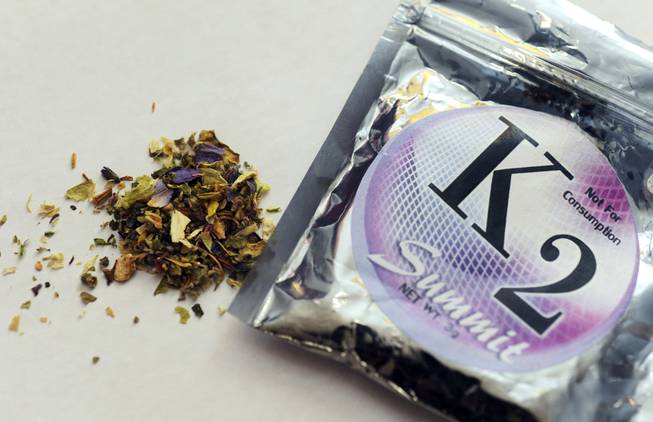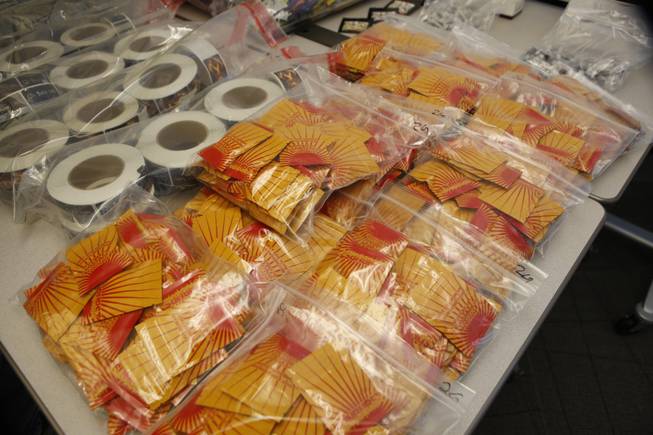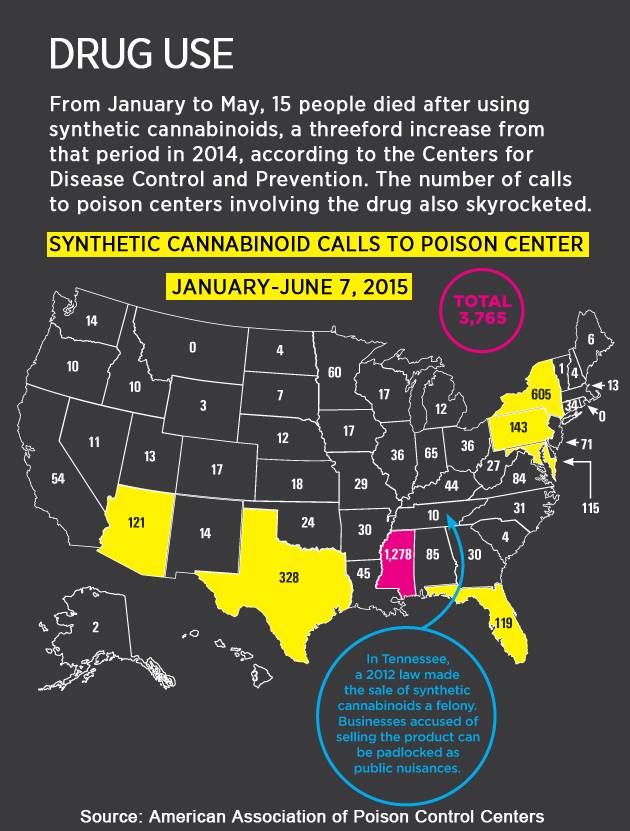
Kelley McCall / AP
K2 is dried herbs sprayed with chemicals. The Virginia General Assembly voted in 2011 to outlaw the use of the chemically treated, smokable leaves, known by names such as “Spice” and “K2,” and bath salts that are snorted or smoked as a hallucinogen.
Monday, June 22, 2015 | 2 a.m.

They come with names like Vanilla Sky, Cloud 9 and Ivory Wave — pale, flaky powders in packets decorated with bubbles or flowers and labeled for innocuous uses: potpourri, plant food or most commonly, bath salts.
But the products’ cheerful packaging and labels that warn “not for human consumption” belie a far more disturbing reality: Tens of thousands of people, mostly teens and twentysomethings, swallow, snort, inhale and inject them to get high.
When ingested, bath salts and other synthetic drugs can increase feelings of joy, social interaction and sex drive. The amphetamine-like stimulants, for many years considered a “legal high,” can mimic the effects of cocaine, ecstasy or LSD. But they also can cause users to experience nausea, vomiting, paranoia, hallucinations, delusions, suicidal thoughts, seizures and death.
And while you won’t find them at your local Bath & Body Works, the drugs still can be bought with little difficulty at a gas stations, head shops or online for about $20 a pop.
Bath salts, along with substances such as K2 (“spice”), 2C-I (“smiles”) and Molly, are part of a nebulous but expanding class of synthetic drugs whose unpredictability resulted in a rapidly growing public health threat that’s difficult to track and police.
Also called “new psychoactive substances,” synthetic drugs are chemical compounds designed to mimic or modify the effects of more established illicit drugs such as heroin, crystal meth and marijuana. Spice, for example, is a synthetic cannabinoid, a synthetic marijuana product designed to mirror the effects of THC. Bath salts are synthetic cathinones, or amphetamines that also may induce delusions. Molly, meanwhile, is sold as a substitute for the synthetic designer club drug MDMA, or ecstasy.
All drugs that aren’t derived from plants or pharmaceuticals can be considered synthetic drugs, although older, lab-made drugs such as LSD, GHB, PCP, MDMA and quaaludes have distinct histories that set them apart from this new emerging class. Newer synthetic analogs frequently fall outside of international control, making their trade and manufacturing difficult to control.
Origins of most synthetic drugs are difficult to trace. Spice first was introduced to European markets more than a decade ago and broke into the United States in the late 2000s. Since 2009, law enforcement officials have encountered more than 240 new synthetic compounds, including 99 synthetic cannabinoids, 52 synthetic cathinones and 89 other compounds.
And that number is growing: 51 new synthetic cannabinoids were identified in 2012, compared with just two in 2009. A total of 158 new synthetic compounds were identified in 2012 alone.
According to the U.S. Drug Enforcement Administration, most wholesale quantities of the drugs are bought online and shipped from distributors in China.
Unlike the drugs they mimic, synthetics are made from a shifting array of compounds that approximate the highs of older controlled substances but vary in intensity and unpredictability. Drug formulas constantly are tweaked according to ingredient availability and to stay a step ahead of law enforcement.
Several overdoses and suicides induced by bath salts or spice have been reported, though the substances’ changing chemical makeup has made it difficult to pin down an exact number. Synthetic cannabinoids accounted for 28,531 emergency department visits nationwide in 2011, up from 11,406 the year before, according to a federal government report. Synthetic cathinones accounted for 22,904 hospitalizations in 2011, two-thirds of which involved other drugs, including other synthetics.

Confiscated synthetic drugs are on display at a news conference at the DEA offices in Centennial, Colo., on Wednesday, May 7, 2014, where it was announced that a federal grand jury in Denver has returned indictments charging nine individuals from across the country with conspiracy and drug distribution charges related to "Spice".
In April, New York Gov. Andrew Cuomo issued a health alert warning after more than 160 people in two weeks were hospitalized after using synthetic cannabinoids. Nationally, several users have been arrested for sudden violence and after psychotic episodes.
Some of the drugs — spice, for instance — are far more addictive than their analogs and quickly build up a person’s tolerance so that more of the drug is needed to get an equivalent high.
For most, however, the risk comes not from daily use but from the uncertainty hidden in each hit. That volatility, along with the drugs’ low price and relative accessibility, is part of the appeal for the drugs’ overwhelmingly young user base.
“Teens to early twenties is the majority of what we find,” said Keith Carter, director of the Nevada High Intensity Drug Traffic Area, a task force comprising federal, state, and local law enforcement officers in Clark and Washoe counties focused on combating drug trafficking and abuse. “It’s the excitement of what’s going to happen, the hallucination. The unpredictability, I do believe, is part of it.”
Sometimes, users may not realize they’re taking synthetic drugs. In February, 10 students at Wesleyan University in Connecticut were hospitalized, several in critical condition, with drug overdoses after taking what they believed was MDMA. It actually was a compound made primarily from AB-Fubinaca, an illegal substance found in synthetic marijuana.
“The guys who sell this stuff don’t have any idea what’s actually in it or what the effects will be, nor do they care,” Carter said.
Policing synthetics can play out like a twisted game of Whac-a-Mole. When one supplier is caught or a particular forumula is banned, other suppliers simply change an element or two in the banned substance to create a new “legal” compound with similar effects.
Federal law offers something of a workaround, allowing many synthetic drugs to be treated as controlled substances if they are chemically or pharmacologically similar to a Schedule I or Schedule II controlled substance. The Synthetic Drug Abuse Prevention Act of 2012 helped expand that by placing 26 synthetic drugs in Schedule I. Since then, dozens of other drugs have been added temporarily to the list, pending administrative action for permanent designation.
But in Nevada, regulation has been slower to catch up. State law still assesses substances by their precise chemical makeup rather than by their effect, making it difficult to stamp out new drugs as they emerge.
“If they don’t know what the product is, there’s not a test for it,” said Dave Wuest, deputy executive secretary of the Nevada State Board of Pharmacy, which helps regulate new substances. “You can’t make something illegal that you can’t test for.”
Putting a blanket ban on synthetic compounds isn’t an option, as doing so could prevent the creation of substances that could be beneficial.
During the past three legislative sessions in Nevada, several bills have been introduced to broaden the pharmacy board’s ability to monitor synthetic substances, but all have failed.
Metro Police try to attack the problem on the ground and have helped temper the market’s growth. In 2012, for example, local officers participated in Operation Log Jam, a crackdown of synthetic drugs in 109 cities. More than 90 people were arrested and more than 19 million packets of synthetic substances were seized nationwide.
In 2014, Nevada High Intensity Drug Traffic Area task forces seized 31 pounds of spice and 22 pounds of MDMA. Officers already have surpassed those numbers this year, but Carter said it’s too soon to tell whether that’s due to increased enforcement, increased availability or other factors.
In December, the Las Vegas City Council passed an ordinance making the sale of spice and other synthetic cannabinoids at smoke shops a misdemeanor.
Overall, national law enforcement data show slight declines in availability, but use has yet to diminish significantly.
As police and lawmakers struggle to catch up with the trend, Carter hopes increasing public awareness of the true nature of these substances, whether through educational campaigns or the growing number of user-made YouTube videos showcasing the drugs’ disturbing effects, will help turn the public against synthetics.
“America has a huge thirst for drugs,” Carter said. “But when you see what these drugs do to people, it really speaks for itself.”

K2 | Also known as spice, Yucatan fire, skunk, genie, blaze herbal incense, fake weed
What it is: K2 is a synthetic cannabinoid, man-made chemical that’s the main psychoactive ingredient in marijuana. Although the substance is chemically related to marijuana and sometimes is referred to as “legal marijuana,” its effects can be far more intense, dangerous and unpredictable than its herbal counterpart.
What the high is like: Designed to mimic effects of THC
Forms: K2 typically is sold as a solid or oil.
It most commonly is sprayed onto a noncannabis herbal mixture to be smoked.
Known effects: Severe agitation and anxiety, nausea, vomiting, hallucinations, rapid heartbeat, elevated blood pressure, seizures, dilated pupils, suicidal and other harmful thoughts and/or behaviors
Notable news stories:In October 2013, a 45-year-old homeless man high on K2 fell after trying to “surf” on top of a moving subway car in New York City. He was pronounced dead on the scene. More recently, emergency medical workers in the Austin, Texas, area reported a spike in adverse reactions to K2. In the two weeks between May 29 and June 15, 235 people who said they had taken spice fell ill and were taken to the hospital.
•••
Bath salts | Also known as plant food, potpourri, jewelry cleaner
What it is: Bath salts is a blanket term for a family of drugs made from synthetic cathinone, an amphetamine-like stimulant naturally found in the khat plant, native to East Africa and the Arabian Peninsula. Substances commonly found in bath salts can include 3,4-methylenedioxypyrovalerone (MDPV), mephedrone (“Meow Meow”) and methylone, but there are many others.
What the high is like: Because of the hallucinatory effects they can produce, bath salts have been compared by users to MDMA, LSD and crystal methamphetamine.
Forms: The white, tan or brown crystalline powders can be taken orally,
inhaled or injected. Bath salts also can come in tablet form.
The most severe effects are associated with snorting or needle injection.
Known effects: Racing heart, high blood pressure, chest pains, paranoia, hallucinations, delirium,
panic attacks, dehydration, breakdown of skeletal muscle tissue, kidney failure, death
Notable news stories:In 2012, it seemed as if America was under attack by zombies. A 31-year-old man was accused of eating off the face of a homeless man. A New York woman said she wanted to “kill someone and eat them,” then tried to bite the face of a police officer. All were attributed to bath salts, although toxicologists later ruled out synthetic cathinones in the case of the homeless attack.
•••
Flakka | Also known as gravel, alpha-PVP, a-PVP
What it is: Stimulant. Also a compound sometimes used in bath salts, flakka is one of the newest and most volatile synthetic drugs available. Relatively little is known about its effect on humans. It is related to cathinone and may be addictive.
Forms: Flakka is produced as a chunky white crystal, hence its “gravel” nickname, that can be smoked, injected, snorted or ingested.
Known effects: Hallucinations, delirium, spikes in body temperature, paranoia, violent behavior, hyperthermia, kidney damage, muscle breakdown, death
Notable news stories:Flakka is wreaking havoc in Florida. In recent months alone: One man ran naked through a neighborhood, tried to have sex with a tree and told police he was the mythical god Thor. Another ran nude down a busy city street in broad daylight, convinced a pack of German shepherds was pursuing him. And two others tried separately to break into the Fort Lauderdale Police Department, claiming people were chasing them. One wound up impaled on a fence.
•••
Mephedrone | Also known as Meow Meow, drone, M-CAT, white magic
What it is: Whether taken alone or as a component of bath salts, mephedrone is an amphetamine.
What the high is like: MDMA and cocaine, including euphoria and increased confidence and energy.
Forms: Mephedrone can be taken as a tablet, capsule or white powder that can be injected, snorted, smoked or swallowed.
Known effects: Insomnia, teeth grinding, muscle clenching, hallucinations, blurred vision, irregular or racing heartbeat, psychological dependency, suicidal and other harmful thoughts and/or behaviors
Notable news stories:In 2013, a British 21-year-old who police said was in a mephedrone-fueled psychosis stabbed his mother 11 times in the neck, back, head and arms before saying “he needed to be punished” for what he had done and cut off a portion of his penis.
•••
Molly | Also known as Methylone
What it is: Though sometimes misused as a pseudonym for MDMA or Ecstasy, Molly is a blanket term for synthetic compounds that vary widely in strength and typically mimic the effects of MDMA and Ecstasy. Molly also often is mixed with other lab-created chemicals, including mephedrone. Synthetic cannabinoids also have been found in compounds sold as Molly.
Forms: Molly most commonly appears as a capsule or powder to be ingested, but it also has been found applied to blotting papers, similar to LSD, and in injectable form.
Known effects: Euphoria, insomnia, increased sociability, depersonalization, hallucinations, psychosis, nausea, vomiting, increased heart rate, hypertension, hyperthermia, sweating, muscle spasms, panic attacks, seizures, death
Notable news stories: Eleven people at Wesleyan University, including 10 students, were hospitalized in February in Connecticut with overdose symptoms consistent with the use of Molly. Two were in critical condition.
Follow Andrea Domanick on Twitter at @AndreaDomanick and fan her on Facebook at Facebook.com/AndreaDomanick.

Join the Discussion:
Check this out for a full explanation of our conversion to the LiveFyre commenting system and instructions on how to sign up for an account.
Full comments policy